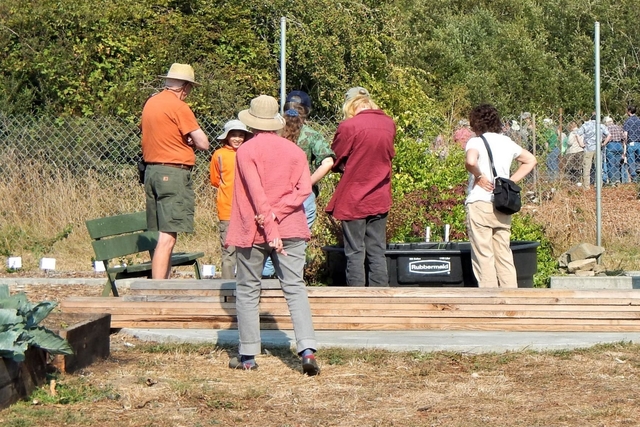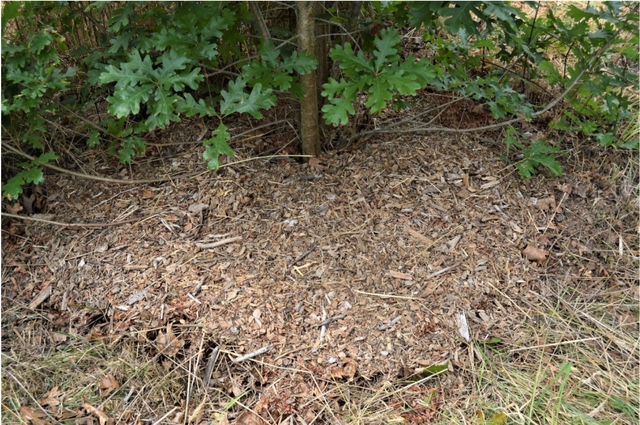Acorns have long been an appealing food source for humans (Šálková et al. 2012). The acceptance of acorns as an alternative modern crop is developing (Vinha et al. 2016). Acorn gathering and processing has provided an exciting opportunity to engage the community and teach food security principles to youth in Northern California (Figure 1). Perennial cropping presents an opportunity to improve agricultural systems with synchrony between crop nutrient requirements and nutrient supplies (Crews 2005). Drought poses a major threat to food security (Fàbregas et al. 2018). These considerations are a sample of the reasons that alternative crops such as nut pines and oak trees were installed in a Northern California food forest to investigate long-term productivity.
 Figure 1. Author’s son as a young teenager (in bright orange shirt) teaching perennial cropping and ecosystem gardening concepts to an adult audience at a community garden tour.
Figure 1. Author’s son as a young teenager (in bright orange shirt) teaching perennial cropping and ecosystem gardening concepts to an adult audience at a community garden tour.
The Fieldbrook Eco Garden was established in Humboldt County, California in 2014 to showcase concepts such as carbon cycling, soil health, and ecosystem services in a community garden setting. Perennial fruits and nuts were installed in a naturalistic setting with hugelkultur mounds demonstrating the ecological advantages of buried hardwood logs and native bunchgrass companion plantings. The primary goal was to capture public interest and provide education in ecological gardening concepts using low-maintenance perennial crops that build habitat with minimum inputs.
During annual public tours, diverse audiences included botanists, permaculturalists, rangeland scientists, engineers, farmers, university students, Department of Fish and Wildlife staff, county staff, and local city representatives, along with community members. The response to the principles presented at every tour was overwhelming enthusiasm. Of the various ecological gardening concepts portrayed, agroforestry with nut pines and edible acorn oaks brought the greatest response. Of the several pine and oak species installed, the sweet acorn oak hybrid generated the most enthusiasm, since attendees had never heard of an acorn that could be eaten directly off the tree.
The relatively recent availability of low-tannin acorns has been a novelty used previously by hunters to attract game such as deer and turkeys. Installation of such hybrid oak trees as potential human food had not been observed in Northern California, so a sweet acorn oak hybrid was purchased from Rhora’s Nut Farm and Nursery in Ontario, Canada (Figure 2). A special United States Department of Agriculture permit was acquired to inspect and import the tree. Two valley oaks (Quercus lobata) had been grown from seed and were installed to complete an oak grove in the food forest.

Initial tree installation involved adding dolomite lime to increase soil pH and compost to provide additional soil structure, nutrient holding capacity, and water supply. After installation, a heavy layer of wood chip mulch was applied over the soil surface to emulate forest floor duff to reduce soil temperatures, retain soil moisture, and provide organic matter for the soil microbiological community (Figure 3). The tree was hand watered several times during establishment, and then left to the elements for the next six years.

Local experience has shown that many native oak species produce acorns that require from seven to 15 washings to leach the tannic acid and produce a palatable meal. The valley oak proved to be one of the best acorns for consumption, with only seven leaching sessions required. After discovering the sweet acorn oak hybrid that could be harvested and eaten directly without leaching, the tree was acquired and installed during the spring of 2014. Six years later, in 2020, we have our first crop (Figure 4). The tree canopy has reached an approximate height of nine feet and width of six feet.

With the severity and frequency of disasters (such as wildfires and droughts) experienced throughout North America in recent years, developing crops that are drought tolerant, fire resistant, soil stabilizing, carbon sequestering, and produce more food with each passing year provides food security and ecological resilience. Oak trees meet these criteria, while providing wildlife habitat, shade, and other products such as fuel, tools, and biochar feedstock. The fall of 2020 will be an exciting time as we quantify the first harvest and sample the palatability to determine the quality of this unique, perennial crop that has brought so much applause and fascination to our community.
References
Crews TE (2005) Perennial crops and endogenous nutrient supplies. Renew Agriculture Food Syst 20. 10.1079/RAF200497
Fàbregas N, Lozano-Elena F, Blasco-Escámez D et al. (2018) Overexpression of the vascular brassinosteroid receptor BRL3 confers drought resistance without penalizing plant growth. Nat Commun 9, 4680. https://doi.org/10.1038/s41467-018-06861-3
Tereza Šálkováa, Michaela Divišováa , Štěpánka Kadochovác , Jiří Benešb , Kateřina Delawskáa , Eva Kadlčkováa , Lenka Němečkováa , Kamila Pokornáb , Václav Voskaa , Andrea Žemličková (2011) Acorns as a Food Resource. An Experiment with Acorn Preparation and Taste. Interdiscip Archeol 2/2011:139-147. http://iansa.eu/papers/IANSA-2011-02-salkova.pdf
Vinha AF, Barreira JCM, Costa ASG, Oliveira MBPP (2016) A new age for Quercus spp. fruits: review on nutritional and phytochemical composition and related biological activities of acorns. Compr Rev Food Sci Food Saf 15:947–981

